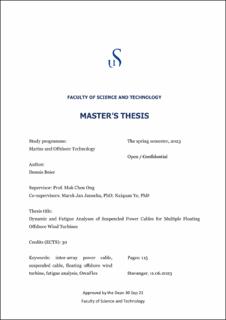| dc.description.abstract | Floating offshore wind turbines (FOWTs) are installed to effectively capture energy from offshore wind in deeper water areas where building bottom-fixed offshore wind turbines is not practical. The present study focuses on the application and fatigue life of suspended inter-array power cables in floating offshore wind farms. A spar type and a semi-submersible type FOWTs are modeled in the dynamic analysis software OrcaFlex and validated against reference studies. The power cable connecting the FOWTs is installed fully suspended with attached buoys. The impacts of marine growth on the power cable and the non-linear bending behavior of the cable are considered in the analyses. Representative environmental conditions for the North Sea are applied to assess the dynamic responses of the model. Different cable configurations connecting two spar FOWTs are evaluated based on Fitness Factors using static and dynamic analyses. The number of buoys is identified as the main parameter determining the maximum effective tension and the minimum bending radii of the cables. The vertical excursion of the suspended cable depends on the buoy spacing. The effect of cable length and marine growth on cable tensions and curvatures is small. Two semi-submersible FOWTs are connected using the most suitable cable configuration obtained for the two spar FOWTs. The impact of the floater type on the tension and curvature of the power cable is determined to be very small. A two-turbine configuration with various environmental load directions is identified to be representative of the suspended power cables design in whole wind farms, according to analyses of power cable behavior in various offshore wind farm layouts. To investigate the fatigue life of the power cable, the relationships between the axial tensions and curvatures of the power cable and its stresses are obtained by cross-section analysis in UFLEX. The optimum cable in the spar setup has a fatigue life of 85 years, with curvature-induced stresses being identified as the primary cause of the fatigue damage. The power cable's fatigue life reduces when marine growth effects are considered. A decrease in the number of buoys attached to the cable and the use of semi-submersible FOWTs increase the fatigue life. The armor wires are the critical components, and the highest fatigue damage always occurs adjacent to the buoys. The largest fatigue damage results from environmental loads approaching the power cable from a crossflow direction. | |
